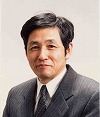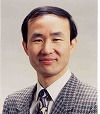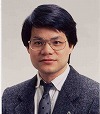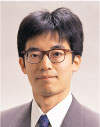|
|
 |
|
|
Image Processing Laboratory |

Shunji Mori
Professor |

Jintae Lee
Associate Professor |

Won-Hee Park
Visit Researcher |

Konstantin Kolchin
Visit Researcher |

Tony Y.T. Chan
Assistant Professor |

Yu Nakajima
Research Associate |
|
This year also wewere active in both researchand education. That is, 2 journal papers were published at least and 4 conference papers were presented at least. Concerning the education 5 graduation research theses and 6 master theses were supervised.
On the other hand, we contributed domestic companies. Prof. S. Mori continued big project of Automatic SignatureVerification Systemcooperated with Nihon University, Tohoku University, and Axiom Ltd., which was supported by NEDO last year. He instructed Aiko Engineering Ltd. to develop vector conversion system of land property map.The system is based on pyramid hierarchal structure and precise so that it satisfies the spec. of the customer.
Prof.Tony Chan did good job on his research area of learning based on artificial approach. He also contributed academic committee serving as an associate editor of Journal of Applied Systems Studies and a chairperson for the session Neural Networks I, the 8th International IEEE Conference on Electronics, Circuits, and Systems. However,it is our deep sorrow that we lost an excellent researcher as well as instructor in our laboratory,Associate Professor Jintae Lee.Because of his sudden death,S.Mori's retire,and the System change all the record of his research work was lost.Therefore,his contribution was not described here. That is meaning of "at least".
|
| [kvkol-001:2001] | R. Durikovic and K. Kolchin. Physically-Based Model of Photo-graphic Effects for Night and Day Scenes. The Journal of Three Dimensional Images, 15(4):119-124, 2001.
We consider optical effects in a photographic camera that result in glares aroung light sources on photos. We suggest a physically based model for parts of glare known as bloom and corona. Based on this model, we derive digital filters that operate on a radiance map image obtained in a rendering systme or a high dynamic range image. Images thus obtained simulate photos with photographic bloom and corona glares around luminairs. |
| [t-chan-001:2001] | Tony Y. T. Chan. Unsupervised Classification of Noisy Chromosomes. Bioinformatics, 17(5):438-444, May 2001.
Almost all methods of chromosome recognition assume supervised training; i.e., we are given correctly classified chromosomes to start the training phase. Noise, if any, is confined only in the representation of the chromosomes and not in the classification of the chromosomes. During the recognition phase, the problem is simply to calculate the string edit distance of theunknownsto the representatives chosen from the training phase and classify the unknowns accordingly. In this paper, a general method to tackle the difficult unsupervised induction problem is described.A success of themethod is demonstrated by showing how the inductive agent learns weights in a dynamic manner that allows it to distinguish between noisy median and telocentric chromosomes without knowing their proper labels. The process of learning is characterized as the process of finding the rightdistance function, i.e., the distance function that can nicely separate the classes. |
| [t-chan-002:2001] | Tony Y.T. Chan. Unifying Metric Approach to the Triple Parity. Artificial Intelligence, 2002.
Accepted for publication |
| Referred Proceeding Papers |
| [s-mori-001:2001] | M. Tanabe, H. Yoshihara, S. Kameya, S. Mori, Omata, and T. Ito. Automatic Signature Verification Based on the Dynamic Feature of Pressure. In Editor R.M.Haralic, editor, Proceedings of the Sixth International Conference on Document Analysis and Recognition - ICDAR 2001, pages 1045-1049, New York, September 2001. IPA, IEEE.
Feasibility experiment on an automatic signature verification system based on writing pressure was conducted using a new device sensing z-axis component of writing pressure. The data acquisitions were conducted over a half a year, for checking both subjects' and device stabilities. The DP matching method provided 6type I and type II errors. Some natures of signatures of writing pressure were investigated. |
| [t-chan-003:2001] | Tony Y. T. Chan. Unsupervised Classification for the Triple Parity Strings. In Proceedings of The 8th IEEE International Conference on Electronics, Circuits and Systems, volume 2, pages 615-618. IEEE Computer Society, 2001.
A method is proposed for supervised and unsupervised learning to classify bit strings for three classes. The learner was modeled by two formal concepts, transformation system and stability optimization. Even though a small set of short examples were used in the training stage, all bit strings of any length were classified correctly in the online recognition stage. The learner successfully learned to devise a way by means of metric calculations to classify bit strings according to 3-parity-ness, while the learner was never told the concept of 3-parity-ness. |
| [t-chan-004:2001] | Tony Y. T. Chan. Fast Naive-Euclidean Learner. In Proceedings of the 2nd IEEE International Conference on Systems, Man, and Cybernetics. IEEE Computer Society, 2002.
Accepted for publication |
| [s-mori-002:2001] | T. Matsushita, T.Nakamura, D. Matsumoto, L. Sone, A. Hoshi, and S. Mori. Kanji Learning System. In Editor D.Wei, editor, Proceedings of the Second International Conference on Computer and Information Technology (CIT'200), pages 133{138, Shanghai, September 2001. CIT, Shanghai University Press.
This paper presents anew system for learning Kanji characters in terms of the shape and writing order. It is said that they are hard to learn for pupils in elementary schools and foreigners. The systemwasmadeimaging an instructor who teaches Kanji character writing. This means that the system gives appropriate evaluation to a written Kanji shape together with the correct writing order. On the other hand, for children the system has to provide friendly interface. Those requirements are achieved in the Kanji learning system. |
| [t-chan-005:2001] | Tony Y. T. Chan. Pattern Learning: A Unifying Approach. Kluwer Academic Publishers, Boston, 2003.
To be published |
| [t-chan-006:2001] | Tony Y. T. Chan, 2001.
Associate editor, Journal of Applied Systems Studies |
| [s-mori-003:2001] | Masaru Nanba. Master Thesis:Contour Sharpening for Binarization Methods, University of Aizu, 2001.
Thesis Advisor: Shunji Mori. |
| [s-mori-004:2001] | Masataka Kishihara. Master Thesis: Region segmentation based on hierarchical stracture, University of Aizu, 2001.
Thesis Advisor: Shunji Mori. |
| [s-mori-005:2001] | Taro Nakamura. Mater Thesis: Creating Walking Animation from Footprints, University of Aizu, 2001.
Thesis Advisor: Shunji Mori and Jinten Lee. |
| [s-mori-006:2001] | Daisuke Saito. Mater Thesis: Interactive Painting with Virtual Brush Model, University of Aizu, 2001.
Thesis Advisor: Shunji Mori and Jinten Lee. |
| [s-mori-007:2001] | Yaser Mohamed Asem Mohamed. Mater Thesis: Internet Traffic Evaluation by Hidden Markov Modeling, University of Aizu, 2001.
Thesis Advisor: Shunji Mori and Hiroshi Toyoizumi. |
| [s-mori-008:2001] | Yuichirou Goto. Mater Thesis: Interactive modeling and visualization of F Rep solids with an extendable user interface, University of Aizu, 2001.
Thesis Advisor: Shunji Mori and Carl W. Vilbrandt. |
| [s-mori-009:2001] | Akinori Kaneki. Graduation Thesis: Automatic Signature Verification for Japanese Based on Discrete Fourier Transformation, University of Aizu, 2001.
Thesis Advisor: Shunji Mori. |
| [s-mori-010:2001] | Reiko Furusawa. Graduation Thesis: Automatic Wood Knot Visual Inspection, University of Aizu, 2001.
Thesis Advisor: Shunji Mori. |
| [s-mori-011:2001] | Chie Takahashi. Graduation Thesis: Recognition of Class Evaluation System, University of Aizu, 2001.
Thesis Advisor: Shunji Mori. |
| [s-mori-012:2001] | Kouji Kawamoto. Graduation Thesis: Evaluation of Kanji Characters Based on Stroke Positions and Direction, University of Aizu, 2001.
Thesis Advisor: Shunji Mori. |
| [s-mori-013:2001] | Takashi Wada. Graduation Thesis: Preprocessings for Automatic Visual Inspection of the Printed Matter on a Car Window, University of Aizu, 2001.
Thesis Advisor: Shunji Mori. |
| [s-mori-014:2001] | A. Pasko and C. et al Vilbrandt. HyperFun Project: Language and Software Tools for Functionally Based Modeling, Visualization and Animation. CDROM free distribution under the GGPL agreement for ACM1: Beyond Cyberspace, San Jose, California, USA, March 2001. |
|